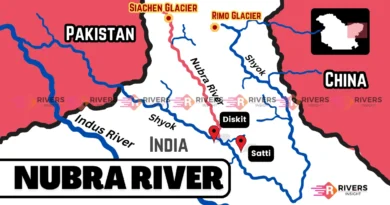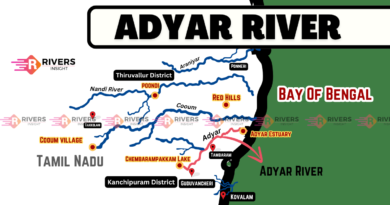Mandakini River: Origin from Chorabari Glacier | Map
The Mandakini River originates in the Chorabari glacier near the Kedarnath temple and flows gracefully through the Himalayan terrain before merging with the Alaknanda River at Rudraprayag. This sacred waterway, known for its peace and purity, has religious significance in Hindu mythology and is a lifeline for the surrounding ecosystem.
This article will look at the Mandakini River’s geographical features, such as its origin, course, length, tributaries, and drainage basin.
Table of Contents

Geographical Features of Mandakini River
- Length: Approximately 80 kilometers.
- Tributaries:
- Bhilangna River
- Balasuti River
- Kali Ganga River
- Drainage basin: Encompasses the Garhwal region, including forests, peaks, and valleys.
Origin and Course of Mandakini
The Mandakini River originates from the Chorabari Glacier, situated near the Kedarnath Temple in Uttarakhand, India, at an altitude of approximately 3,583 meters (11,755 feet). The glacier is fed by snowfall and melting ice from the surrounding peaks, including the Kedarnath Peak, which stands at an elevation of 6,940 meters (22,800 feet).
From its source, the Mandakini River flows southeastward through the rugged Himalayan terrain, passing by the sacred town of Kedarnath, an important pilgrimage site. The river then flows through the valley of Gaurikund, where the ancient temple of Gauri Devi is located. Further downstream, the river passes by the village of Sonprayag, known for its natural hot springs, and then continues towards Rudraprayag, where it merges with the Alaknanda River, marking its integration into the larger Ganges River system.
Along its course, the Mandakini River also passes by the Triyuginarayan Temple, a sacred Hindu temple dedicated to Lord Vishnu, and the village of Tilwara, which is famous for its scenic beauty and trekking trails. It is considered a sacred river in Hinduism and is mentioned in several ancient texts, including the Mahabharata and the Puranas.
Historical Significance
The Mandakini River has deep historical significance in the region, dating back to ancient times. It is regarded as a sacred waterway in Hindu mythology, with references in religious texts and epics such as the Ramayana.
The river has witnessed the rise and fall of civilizations, serving as a lifeline for trade, transportation, and agriculture throughout history. Its banks are adorned with temples, ashrams, and settlements that reflect the region’s rich spiritual and cultural heritage.
Confluence of Mandakini: Rudraprayag, where the Mandakini merges with the Alaknanda, exemplifies India’s rich spiritual heritage. Rudraprayag, revered as a sacred site dedicated to Lord Shiva, entices devotees and visitors with its spiritual aura and natural beauty.
The confluence point remains a pilgrimage destination, attracting those seeking spiritual cleansing and solace.




wow, thank you so much for sharing the informative article this article is really helpful for people thank you so much again